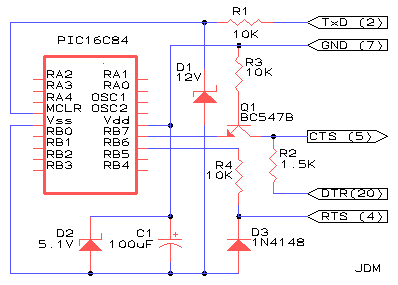- http://www.cosmodog.com/pic/ (cached 20010402083839) picp - open source (free) command line interface for the PICStart+ (read: It writes out the MPLAB commands to cause the PICStart+ to work. Its Open Source. Hint: If you want to make a programmer MPLAB compatable you would.... BING!)
-
Using the Picstart Plus for
ICSP
Because they are implemented as HID devices, you can NOT run them in Windows XP mode as the supplied virtual environment does not allow "Attach" to HID devices, even if they are listed. It may be possible with VirtualBOX.
Embed Inc has PIC programmers and other items for PIC developers. See www.embedinc.com/products. The EasyProg may be of interest to hobbyists. Also the $80 USBProg.
- http://www.picwiser.com/ modified for 16F877
- http://www.dontronics.com/p16pro.html commercial software supporting many PICs on the Tait hardware
- David Tait says: "there is free Windows software for all "Tait" programmer variants available here: http://www.man.ac.uk/~mbhstdj/piclinks.html
-
http://www.lpilsley.co.uk/
Nigel Goodwin dos, win16 and
win32, 16C84, 16F84, 16F627-628 and
'877 software for
use with Tait and Dontronics programmers.
Source code. Includes dissassembler.
- http://members.fortunecity.com/rcabezas/noppp9x.htm for windows 9x
- -Remove-overby at TakeThisOuTrrnet.com says "at http://users.ntr.net/~overby/src/16pro/ I've changed the NOPPP for Linux to suport the 16Pro board. I'm also changing it to use commandline options and support more PIC types."
- http://www.covingtoninnovations.com/noppp/ for DOS
- http://www.uni-saarland.de/~c.fuetterer/cf/pic.html for Linux
- http://www.ramseyelectronics.com/ sells a kit called picpro for about $60.
- http://baserv.uci.kun.nl/~smientki/Lego_Knex/Lego_electronica/PicProg/PicProgrammer_hardware.htm NOP RS232 serial port programmer (hardware + software)
- bc(at)riana.com refers to " http://www.riana.com/electronics/pic Here is a link to a site where you can download a program that will flash PIC12F675's, 16f877's and (soon) 18f452's with you NOPPP style programmer." +
http://www.k9spud.com/hoodmicro/ I have made a development kit for PIC12F6xx microcontrollers called the HOODMICRO. This kit has a small circuit board that fits neatly inside a DB9 to DB25 plastic enclosure. It allows you to rapidly program your microcontroller chip and then execute the code, without having to swap chips or cables. The DB25 connector allows you to interface the PIC12F6xx chip with the outside world, via standard DB25 cables or an "expansion module" circuit of your own design.It is also possible to program other PIC microcontrollers using the DB25 connector via ICSP, but this doesn't provide any enclosure for your microcontroller.
chris(at)jazzysystems.com asks:
Can the Yap-II program the PIC16F627 chip used in Myke Predko's Programming
Robot Controllers. The Yap-II is conspicuously not mentioned and nothing is
mentioned in the Errata or on the Internet that I could find.
Alice Campbell says:
I found the QANDD programmer quit eating my F84s when i put a blocking diode between the 5volt rail and the MCLR pin. there may be a path for 13 volts to sneak up to the 5v rail via the MCLR pullup. 13 volts is too much for any other pin than MCLR.
Roman Black advises:
- use a 47k resistor betweeen Vdd pin and MCLR pin
- use a 470 ohm resistor for 13v to MCLR
David Tait says:
The problems that people are having with the Q&D circuit seems to stem from trying to use it while the PIC is in circuit. The low value of /MCLR pullup resistor specified could (depending on what other circuitry is attached to /MCLR) pull the 5V rail out of spec. This URL has some information on using the quick-and-dirty approach in-circuit: http://www.ubasics.com/adam/pic/icp84.html
http://www.jdm.homepage.dk/newpic.htm Hi,i started learning all about pics 3 months ago,i found a very good programmer that works gr8 with most pics ..16f84 ...16f877. it is jdm programmer..very simple and works very well the software used is icprog..simple and nice so if u r looking for a programmer..i advise you to try this one
I found one more circuit by the same author (JDM) with a few more components. That is working fine with the PIX program for programming my 16F84A PICs. It's quite fast too.
(serial port programmer: one transistor, a few diodes, resistors and
capacitors)
corp0197(at)hotmail.com
asks: " Does the JDM programmer Bala Chandar
posted work with PIC12C508 like some other programmers do, and if so where
do you connect the pins?"
- Steve Merchant - Nottingham University - PP84 fast software and PROG84 programmer - AN589 with clock, 12v supply and status lights
- http://members.vol.at/home.floery/electronix/picprg/picprg.htm AN589 with software for Linux
-
Robert Spur - Analog Design Specialists
Microchip appnote AN589 C
source
../piclist/cheapic/com84.htm
Darrell Higgins comments:
Hi, I have had the Picall programmer for a while now ( I got it from Amazon electronics) It has worked fine up untill yesterday when I tried to start it and got this message: "Couldn't start IO driver for Windows NT/2000.XP. for running PICALLW under Windows NT/2000/XP you must have administrator privilee in order to install and start IO driver If you continue your system may become unstable" I am running windows xp and I am logged as administrator ( I am the only user) .. and as I said it worked fine before ... i have not used the programmer for a month or so so I tried the new "system restore" and went backa few days and still no go Have you ever heard of this and can ou give me any suggestions It works fine in win98 on my dual boot system, but I kind of get tired switching back and forth from 98 to xp
I got similar problem before. Cos Win2000/XP has strict control over IO ports. Must load appropriate driver to gain access to IO ports in UserMode. Typing this at command prompt works for me:
C:\picall\picallnt -l c:\picall\picallnt -p
The files picallnt.exe and picallnt.sys are available in latest version of
PICALLW but these files work on earlier version too.
